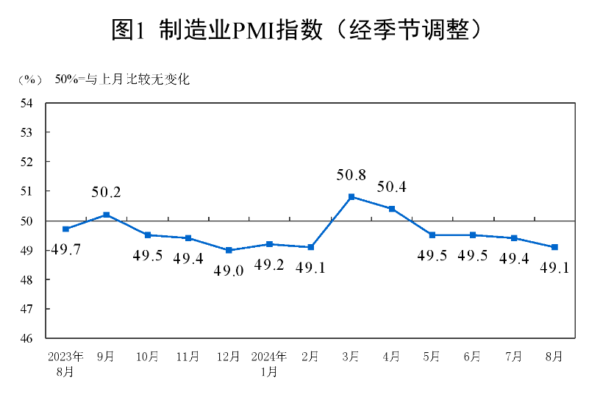On August 31, the National Bureau of Statistics of the Chinese Communist Party (CCP) released the Purchasing Managers’ Index (PMI) for the manufacturing sector in August, which stood at 49.1, a decrease of 0.3 percentage points from the previous month. This marks the fourth consecutive month that the PMI has remained below the threshold of 50, indicating contraction in the manufacturing sector.
According to the data on the operational status of the China Purchasing Managers’ Index in August released by the International Statistics Bureau of the CCP, the PMI for August was 49.1, a 0.3 percentage point drop from July, marking the fourth consecutive month below the threshold. The non-manufacturing business activity index was 50.3, up 0.1 percentage point from the previous month. The comprehensive PMI output index was 50.1, down 0.1 percentage point from the previous month, marking the fifth consecutive month of decline and the lowest since January 2023.
In terms of enterprise size, in August, the PMI for large enterprises was 50.4, a decrease of 0.1 percentage point from the previous month; while the PMI for medium and small enterprises was 48.7 and 46.4 respectively, showing decreases of 0.7 and 0.3 percentage points from the previous month, indicating increased operational pressures for medium and small enterprises.
The components that make up the manufacturing PMI include production index, new orders index, raw materials inventory index, employment index, and supplier delivery time index, all of which were below the critical threshold.
Specifically, the production index for August was 49.1, a 0.3 percentage point decrease from the previous month, marking the first time since March that it fell below the threshold, suggesting a slowdown in manufacturing production activities. The new orders index dropped 0.4 percentage points to 48.9, the lowest value this year. Although there was marginal improvement in export conditions in August with the new export orders index rising to 48.7 in the contraction zone by 0.2 percentage points, the import index fell to 46.8. The employment index was at 48.1, down by 0.2 percentage points from the previous month, indicating a sluggish job market in the manufacturing sector for six consecutive months. The supplier delivery time index was 49.6%, a 0.3 percentage point increase from the previous month but still below the critical threshold, indicating a continued extension of delivery times from raw material suppliers in the manufacturing sector.
Analysis of the August PMI by Caixin found that the data shows the continued impact of shrinking manufacturing demand spreading to the production side.
Moreover, the operational status of China’s non-manufacturing PMI in August indicated a continuous decline in prices due to insufficient demand and fluctuations in prices of bulk commodities such as crude oil, coal, and iron ore. The price indexes for primary materials procurement and factory gate prices in August were 43.2 and 42.0 respectively, down by 6.7 and 4.3 percentage points from the previous month, hitting the lowest values since June 2023.
Insufficient demand led to a further weakening of enterprise purchasing intentions. The procurement volume index in August dropped by 1 percentage point to 47.8, the lowest since January 2023. The raw materials inventory index decreased slightly by 0.2 percentage points to 47.6, while the finished goods inventory index rose by 0.7 percentage points to 48.5.
Wang Qing, Chief Macro Analyst at Orient Jincheng International Credit Rating Co., analyzed for Interface News that due to the slightly weak property market, traditional industries such as steel and chemicals have relatively low operating rates, and consumer spending remains subdued, all of which have to some extent dragged down the manufacturing sector’s business sentiment. Two major uncertainties exist in the future trends of manufacturing. First, the Global Manufacturing PMI of JPMorgan Chase in July contracted for the first time this year, raising uncertainties in external demand trends. Second, whether the drag effect of the real estate industry on the overall macroeconomic operations will increase further.
PMI is an index compiled through monthly surveys of enterprise purchasing managers, covering various aspects including procurement, production, and circulation, in both the manufacturing and non-manufacturing sectors. It is one of the leading indicators used internationally to monitor macroeconomic trends, providing strong predictive and warning functions.
The National Bureau of Statistics of the Chinese Communist Party’s official website states that the calculation method for the manufacturing PMI index is based on a weighted calculation of five diffusion indexes (classification indexes). The weighting of these five classification indexes is determined based on their leading impact on the economy. Specifically, the new orders index has a weight of 30%; the production index has a weight of 25%; the employment index has a weight of 20%; the supplier delivery time index has a weight of 15%; and the raw material inventory index has a weight of 10%. It is worth noting that the supplier delivery time index is a reverse index, and reverse calculations are performed when synthesizing the manufacturing PMI index.

